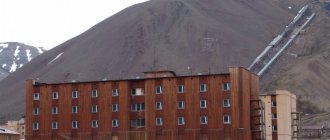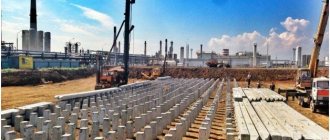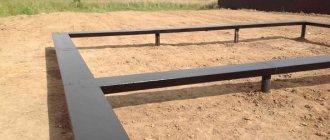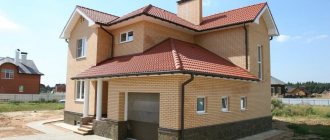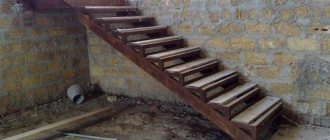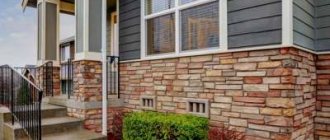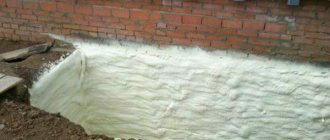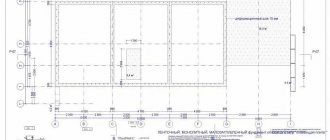The construction of any house is inextricably linked with the construction of a reliable foundation that ensures the stability of the structure. Without information about advanced technologies, some developers construct a strip foundation or build a slab version of the foundation. At the same time, on problematic soils and in conditions of sloping terrain, it is better to build a house on stilts. The screw base is constructed quickly enough, does not require increased costs and provides the necessary load-bearing capacity. Let us consider in detail the features of the technology.
Construction of houses on screw piles - general information
Screw supports are popular among developers constructing buildings on problematic soils. The decision to build a house on screw piles is made in certain situations:
- when the construction site is located on loose soils, soft soils, as well as wet soils with close groundwater;
- with significant differences in heights in the area of the construction site, as well as during the construction of a building in conditions of inclined terrain;
- if there is a lack of financial resources for the purchase of building materials intended for the construction of another type of foundation;
- if necessary, carry out the construction of a light frame structure or wooden house in a limited time;
- if there is no financial opportunity to build a drainage system in swampy soil for building a house.
The reliability and service life of the building depend on the correctly chosen type of foundation.
Screw piles for a house have a simple design and consist of the following elements:
- a steel pipe that takes the axial load from the building;
- working tip welded to the end of the pipe.
The construction of a house on screw piles is carried out according to a certain algorithm. Sequencing:
- Conduct a soil test.
- Develop project documentation.
- Decide on the design and dimensions of the elements.
- Calculate the number of supporting elements.
- Mark the location coordinates.
- Prepare materials, tools and equipment.
- Screw the columns into the ground.
- Trim the pipes to the general level.
- Weld the bearings to the pipes.
- Mount the grillage.
- Insulate the supporting structure.
- Build the building according to the project.
Let's evaluate the features of the technology.
Thanks to this technology, construction can be carried out on water and unstable soils
Examples of calculating the depth of immersion of piles
The immersion depth is calculated empirically. But the depth of dense layers of soil is difficult to calculate, since it is a random variable. Therefore, the only correct option is to drill a test well or drive a test pile, which allows you to find out the depth of hard soil rocks. SNiP requires this to be done, and other methods do not provide reliable information.
The depth determined by the trial method is one of the indicators that are used when performing subsequent calculations. Calculations for a pile-grillage type foundation also involve determining the number of piles per structure. It is obtained by dividing the estimated weight of the house by the load-bearing capacity of 1 support. So, if the nominal weight of the house is 10 tons, and the load-bearing capacity of the pile is 1 ton, then 10 piles are needed.
The pile distribution scheme depends on the design of the house - its configuration. The most critical areas in the foundation are the corners of the structure. During the design process, a pile is first placed at each corner and the point of contact with load-bearing walls and other loaded units is determined. Next, the remaining supports are evenly distributed to adequately perceive and distribute the load.
Experienced designers advise to provide a certain margin of safety for the foundation so that it can withstand additional loads from operation and extensions.
Building a house on screw piles - design features
The basic element of the foundation is tubular elements with a spiral tip. The construction of houses on screw piles is carried out using supports of various designs. They differ in the shape of the working tip.
The profile could be as follows:
- standard, in the form of one full turn welded in the pipe. It is part of the foundations of light buildings;
- reinforced, consisting of two intermittent turns welded to the pipe. Able to withstand increased loads;
- narrow-blade, made in the form of a cast conical nozzle. Suitable for rocky soils;
- cylindrical in the form of a continuous spiral of constant diameter. Designed to work in permafrost conditions.
Before building a house on screw piles, you need to decide on the type of supports.
A special feature of a screw foundation is the immersion method. The piles are not driven into the soil by successive blows, but are screwed by applying a torque. As the pipe rotates, its cone-shaped tip gradually moves deeper into the soil. Reliable fastening is facilitated by compaction of the rock during the screwing process.
When choosing piles for your home, you need to consider the following points:
- grade of steel used for their manufacture;
- thickness of the coil in the working part;
- the size of the pipe wall, which determines its durability;
- quality of welds in the nozzle attachment area;
- the shape of the working blades and the total length of the support element.
The load from the mass of the structure is evenly distributed across all columns. This is achieved by leveling the tops of the pipes and securing the ends. A grillage is attached to the supports, which unites the columns into a common power circuit.
To make a grillage, choose one of the following materials:
- steel channels or I-beams;
- wooden beams;
- concrete blocks.
Such a foundation is reliable. After all, the load from the building is transferred to the grillage, which rigidly connects the columns. A quickly erected foundation allows the construction of a house to be completed in a limited time.
A pile foundation includes a group of piles interconnected by a grillage
Technology of laying gas blocks
How is aerated concrete installed on a pile foundation? A waterproofing layer is placed under the first block row so that the stones do not absorb moisture from the grillage. After this, a number of blocks are laid out on cement mortar; subsequently, an adhesive mixture is used for this purpose.
Masonry work is carried out from the corners, between which the cord is stretched. If it is necessary to fill a row completely, an additional element of the required size is cut out of a solid block. All subsequent rows are performed with a half-block dressing, as is the case with brickwork.
The glue is applied to the surface of the blocks with a spatula or a carriage whose width corresponds to the size of the stone. The seam is not made thick, because the glue has excellent adhesive properties. To level the blocks laid in a row, use a rubber or wooden mallet.
To prevent cracks on the surface of the walls, a reinforcement method is used. This operation is performed during the construction of any large building, and for an aerated concrete house built on a pile foundation, it will not be superfluous. Not all rows are subject to reinforcement, but only certain ones that are considered the most vulnerable. These include areas with lintels, support points, the first masonry row, and areas located under the openings of window blocks.
Reinforcement is performed along the length of the upper part of the aerated block stone.
The following materials are permitted for this work step:
- double steel wire frame connected by crossbars. It is laid in one layer;
- reinforcing bars with a cross-section of six to eight millimeters. They are laid in two parallel rows, having previously cut grooves in the block material.
House on stilts - advantages of screw supports
When you decide to build a house on stilts, understand the advantages of these supports and their weak points. A house on stilts has the following advantages:
- not picky about soil. It can be built with a high concentration of clay and sand in the soil, as well as on wet soils and quicksand;
- does not depend on the influence of natural factors. Remains stable during temperature fluctuations, frost heaving of soil, shrinkage and soil erosion;
- requires small cash costs associated with the construction of the foundation. A pile field made of supporting elements is a budget solution;
- erected in a short time. After installing the pile elements, the installation of which will take no more than 2 days, construction can begin;
- can be built at any time of the year. The technology of immersion of screw supports into the ground allows work to be carried out in any weather conditions;
- low labor intensity. The design of the pile foundation allows you to build it yourself without the use of special construction equipment;
- can be erected near an existing building. This eliminates the possibility of shrinkage and negative influence of nearby buildings.
The undoubted advantages of columns also include:
- the ability to dismantle supporting elements and reuse them;
- absence of shrinkage, which allows to significantly speed up the construction cycle;
- simplicity of technology that does not require special construction preparation.
The design of this foundation makes it possible to build houses in conditions of sloping terrain, as well as in the absence of access roads for large construction equipment.
The material for making supports is used depending on the type of soil
Construction of walls made of foam blocks on a pile foundation
Walls are erected from foam blocks on a grillage of a pile foundation or on a monolith of a strip-pile foundation. Before this, the surface of the foundation must be covered with a layer of waterproofing.
PB is placed both on a special adhesive composition and on a regular cement-sand mortar. The difference in the price of masonry mortars is leveled by the thickness of the mortar layer between the rows of foam blocks. Cheap cement mortar is laid 20 mm thick. It is enough to lay the expensive adhesive composition at a thickness of 5 mm.
The first row of blocks must be installed on an adhesive mixture with a thickness of at least 30 mm. The remaining rows of masonry are laid on one or another solution.
The walls are laid in the width of the floor of the block or block. Block-thick walls are erected in northern regions, where increased thermal insulation of the external fences of buildings is required.
Scheme of dressing between rows of masonry half a block thick
House on screw stilts - weak points of supports
Along with the advantages, the pile-screw type foundation has a number of disadvantages:
- gradual destruction of supporting columns as a result of corrosion;
- low load capacity on light types of soil;
- the difficulty of screwing elements into soil with a high stone content;
- the need for additional anti-corrosion protection of the working surface;
- inability to assess the condition of an element embedded in the soil;
- the difficulty of organizing a basement in a building on screw columns;
- the need to carry out work on geodetic soil surveys;
- the service life of the columns has been reduced to five decades;
- involvement of designers to develop a detailed design.
Disadvantages also include the increased likelihood of using columns made in artisanal conditions from low-quality materials.
Pros and cons of the foundation
Aerated concrete is lightweight due to its porous structure , where moisture easily penetrates, destroying the structural bonds between the particles of the material. When water droplets freeze during the cold season, they expand in volume, which leads to the formation of cracks. First of all, moisture enters the walls of the house from the soil, so experts recommend raising the basement floor above ground level.
In this case, the main advantage of a pile foundation with an overhanging grillage is expressed - insulation of the structure from contact with loose and waterlogged soil. In this case, the piles provide the necessary stability and rigidity, and the grillage is responsible for the uniform distribution of loads on the load-bearing layer of the earth.
For a pile-grillage foundation, which is applicable for aerated concrete houses,
the following advantages include:
- the possibility of construction in areas with difficult terrain;
- relatively low construction costs;
- durability of the structure due to the connected contour, etc.
The disadvantages of the technology include:
- complexity of engineering calculations;
- the need for high-quality foundation waterproofing;
- labor intensity and high costs of work on the construction of underground premises.
How to build a house on stilts
Having assessed the positive aspects and analyzed the weak points of the foundation, you need to determine whether the selected foundation design is suitable for your building.
Building a country house on stilts has many advantages
This technology ensures the stability of lightweight buildings and structures that can be assembled independently in a limited time:
- frame buildings;
- log baths;
- utility blocks;
- various canopies;
- verandas;
- exit gate;
- wooden and mesh fences.
Let's consider the main stages of constructing a foundation for building a house:
- calculation part;
- immersion in the soil;
- grillage installation;
- insulation of the lower level.
Let us dwell on the features of each stage of work.
Calculating the number of supports
Before design begins, geodetic surveys should be carried out, which include:
- soil sampling and analysis;
- determination of the depth of aquifers.
The load capacity is then determined. For non-critical structures, you can use tabular load capacity indicators for various standard sizes of columns.
Almost all types of pile foundations are designed to withstand the load from low-rise buildings
Let's look at examples:
- a screw support, made on the basis of a pipe with a diameter of 76 mm with a working part diameter of 200 mm, can withstand 1000 kg;
- when the pipe diameter increases to 89 mm and the size of the spiral part to 250 mm, the design load accordingly increases to 2000 kg;
- an element based on a pipe with a diameter of 108 mm and a working part diameter of 300 mm has a load capacity of 250 kg.
The general calculation algorithm involves performing the following work:
- Determination of the mass of the structure. It is calculated by multiplying the volume of the walls by the density of the building material. The mass of the roof and interior elements should be added to the resulting value.
- Calculation of snow load. To calculate the indicator, it is necessary to multiply the roof area of the building by the standard value of the snow load for a particular region.
- Calculation of dynamic load. The value is determined by multiplying the base area by the base value of 350 kg per square meter of surface.
It is also necessary to take into account the wind load. It is determined from tables that take into account the maximum wind speed for a specific region. Having summed up all types of loads acting on the structure, we obtain the total total load perceived by the foundation.
The strength and durability of the house depends on the quality of the material used
. Further procedure:
- Draw a plan of the building, distributing supports in corner areas and under supporting structures.
- Divide the total load by the total number of columns and calculate the load per element.
- Select the design of the supports used, focusing on their load-bearing capacity with a safety factor of 1.2.
When performing calculations, it is necessary to round all values towards a larger value.
Foam blocks
Foam concrete is a relatively new building masonry material. Foam blocks are made from it for building walls. Foam blocks (PF) have gained great popularity due to their quality characteristics.
Standard sizes of foam blocks
PB is manufactured in a factory using special equipment. Foamed cement-sand mortar is treated with hot steam under high pressure. The resulting mass is poured into molds, which are sent to the drying chamber for 2 hours. Then the process of final hardening of the foam mass occurs in the open air.
For the construction of external walls of buildings, PB of standard sizes 390x188x190 mm is used. Blocks 90 mm thick are used for laying partitions. There are varieties of foam blocks with side locking systems - “tenon and groove”. Sometimes the horizontal surfaces of masonry elements are also made in the form of locks, which provide an almost seamless connection of the PB.
Cutting a block with a saw
In terms of their quality characteristics, foam concrete blocks are superior to many of their analogues. Foam blocks are used for laying external fences of multi-storey buildings, where the load-bearing function of the building is performed by the frame of the structure (columns + floors). The porous structure of the material gives the blocks high thermal insulation qualities. In winter, the masonry of the walls does not allow the cold to pass through, and in hot weather it keeps the interior cool.
The main disadvantage of the material is its low load-bearing capacity, therefore, foam block masonry is used as external enclosing structures in houses no more than 2 floors high.
Foam concrete is a fragile material, so any mechanical impact can damage the integrity of the outer surface of the block.
Screwing piles for the house
Follow the specified sequence of actions when screwing:
- Mark and prepare the pits.
- Install the supports sequentially.
- Attach the screwing device.
- Screw in the supports, making sure they are vertical.
- Compact the soil around the column.
- Mark the height of the pipes and cut off the excess part.
- Fill the internal cavities with cement mixture.
After the solution has hardened, install and weld the ends to the top of the pipe.
When choosing a support, you need to study the relationship between the type of soil and the load-bearing load of the pile
We install the grillage
One of the common grillage options is a structure based on a wooden beam.
Using the example of using a beam with a cross section of 15x15 cm, we will consider the sequence of installation actions:
- Soak the wooden beam with an antiseptic.
- Place the beam on the end platforms.
- Join the beams with minimal gap.
- Secure the lower crown with self-tapping screws.
- Lay the cross beams.
- Connect them to the bottom outline.
- Waterproof the wood with mastic.
- Cover the end part of the grillage with boards.
This grillage design is double. A single option is possible, when the joining of longitudinal and transverse beams is made at the ends.
We thermally insulate the supporting part
Insulate the lower part according to the following algorithm:
- Install the sheathing frame.
- Secure the rough sheathing from boards or slabs.
- Make ventilation ducts in it.
- Attach polystyrene foam to the rough sheathing.
- Secure the decorative sheathing over the insulation.
- Install protective pads and visors.
The effectiveness of thermal insulation is influenced by properly performed waterproofing of the soil, as well as insulation and vapor barrier of the floor of the building.
